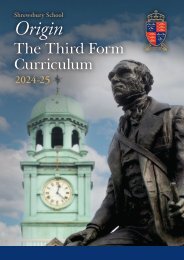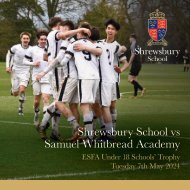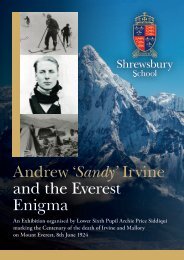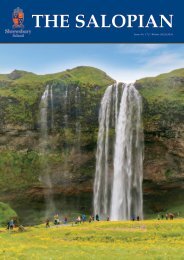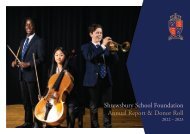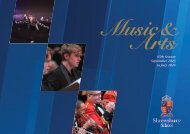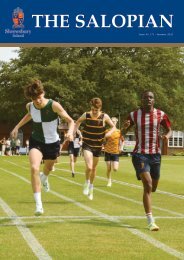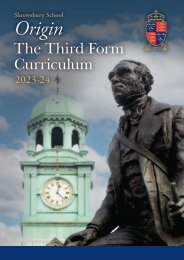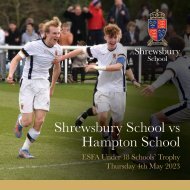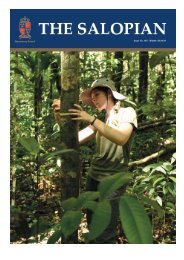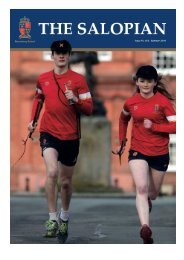The Salopian no. 157 - Winter 2015
Create successful ePaper yourself
Turn your PDF publications into a flip-book with our unique Google optimized e-Paper software.
OLD SALOPIAN NEWS 75<br />
John Edwards (SH 1949-54)<br />
John entered School House Shrewsbury from Packwood<br />
Haugh in 1949 and clearly enjoyed his time there. His<br />
passion for rowing was paramount, especially the days<br />
away rowing at regattas.<br />
John possessed a special wit and humour much enjoyed by<br />
his school mates and even prompted his House Master, Mr<br />
Anthony Chenevix-Trench, on one occasion to remark to<br />
his parents that if all else failed, their son would find work<br />
on the stage. As it turned out, he became an auctioneer and<br />
was never happier than on the rostrum with an appreciative<br />
audience.<br />
Sight problems prevented him doing National Service, so<br />
he went to London College of Estate Management followed<br />
by a year’s practical with Russell, Baldwin and Bright,<br />
auctioneers in Leominster. Eventually he joined his father in<br />
the family firm Campbell & Edwards in Llandrindod Wells.<br />
John soon settled in with the way of local farmers and<br />
buyers at weekly livestock markets in Builth Wells, Rhayader<br />
and Penybont and in his prime would carry a ‘poor trade’<br />
which would be admired by all.<br />
“He appeared to have complete mastery and control over<br />
the auction, an incredible memory for names and kind<br />
words, or the occasional ‘put down’ for those who deserve<br />
it, always with his special sense of humour.”<br />
As new sheep breed societies developed and sheep<br />
numbers increased, John decided to move the large annual<br />
autumn ewe sales to the Royal Welsh Showground at<br />
Llanelwedd. Each of these sales took several days to set up<br />
on different sites on the showground, involving extra staff to<br />
erect sheep pens, co-ordination of catalogues and so on.<br />
<strong>The</strong>se weeks heaped a large amount of strain on John, but<br />
he also took some pride in k<strong>no</strong>wing that at one time they<br />
were the largest sheep sales in Europe.<br />
In 1965 his father retired and Campbell & Edwards merged<br />
with Russell, Baldwin & Bright across the border in<br />
Herefordshire. John became a director and at boardroom<br />
meetings became famous for his ‘one liners’, as well as<br />
‘adding enthusiasm and inspiration to his colleagues’.<br />
John helped create the auctions at the Royal Welsh <strong>Winter</strong><br />
Fayre which was on a par with Smithfield’s Christmas<br />
Fatstock. Yet some of John’s happiest working moments<br />
were conducting furniture sales in the local Church Hall,<br />
which were for many regular attendees a social occasion.<br />
<strong>The</strong>y didn’t come to bid, but to enjoy John’s kindly banter.<br />
He was much missed by the farming community and<br />
buyers from many parts of the country when he took early<br />
retirement, and he had always been a much loved and<br />
respected employer.<br />
John died in March <strong>2015</strong> and is survived by his wife Brenda.<br />
<strong>The</strong>y lost their beloved only child, Caroline, in 1978 when<br />
she was only 13½, leaving a gap in their lives that could<br />
never be filled.<br />
Richard Foster-Pegg (Rt 1933-37)<br />
Richard Foster-Pegg was born in Derbyshire, son of the<br />
chaplain to the Duke of Devonshire at Chatsworth.<br />
During the Second World War he worked as an apprentice<br />
engineer at Rolls-Royce and was involved in the<br />
development of the Merlin engine for the Spitfire and of<br />
early jet engines and turbines. In the 1950s he worked as<br />
a mechanical engineer for the Canadian Government on<br />
coal-fired gas turbines at McGill University and later for the<br />
Bechtel Corporation and for Westinghouse as a designer<br />
of advanced power plants. He acted world-wide as a<br />
consultant and lecturer on power generation, as well as<br />
working for the Department of Energy as a designer.<br />
He was a member of the British Institute of Mechanical<br />
Engineers, the Institute of Energy and the American Society<br />
of Mechanical Engineers and had numerous patents in the<br />
design of turbines for electric power generation.<br />
He died on 20th April <strong>2015</strong> aged 95 and is survived by<br />
Frances, his beloved wife of 67 years, his daughter, Perri,<br />
five grandchildren and one great-grandson. His son Timothy<br />
pre-deceased him.<br />
Keith Fraser (O 1950-55)<br />
A tribute written by John Lavelle (DB 1950-56):<br />
Ian Grant Keith Fraser; four very Scottish names. His family,<br />
luckily for us, decided to settle in Shrewsbury, moving from<br />
the Scottish borders where they had been evacuated, and<br />
thus began a friendship which endured more than 70 years.<br />
Keith was born in Guernsey, but the family had to abandon<br />
their home and all their belongings, bar one suitcase, to flee<br />
the Channel Islands. Before embarking on the last boat to<br />
leave, his father drove the family car into the sea to avoid its<br />
capture by the Germans.<br />
We were at Prestfelde Prep School together and then at <strong>The</strong><br />
Schools. Although Keith’s home, Red Roofs, overlooked<br />
the School Site, he was a boarder in Oldham’s. An above<br />
average wing half, he played for the School 1st X1. I<br />
don’t remember him as a serious cricketer but he was a



